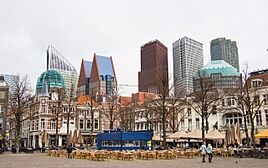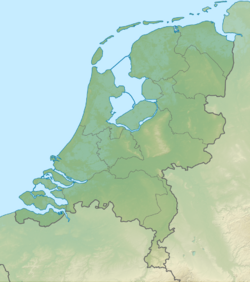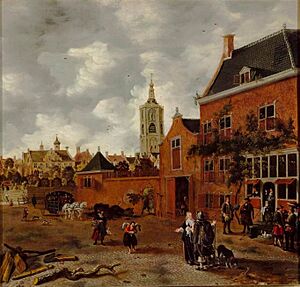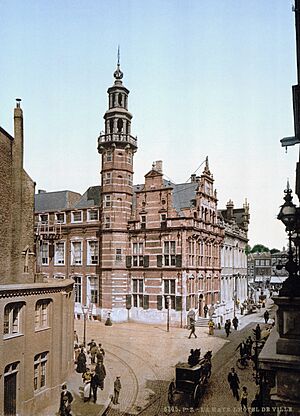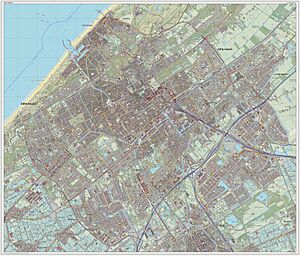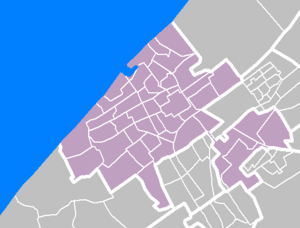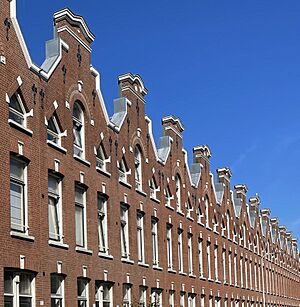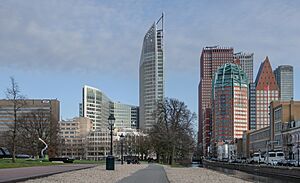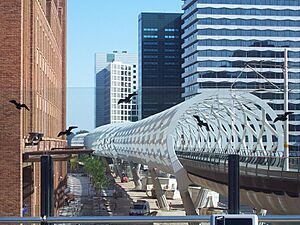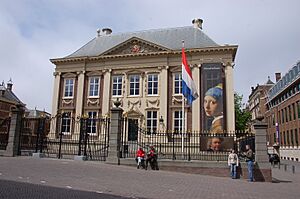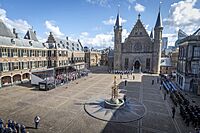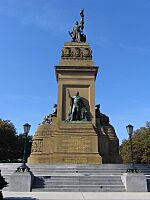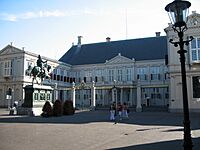The Hague facts for kids
Quick facts for kids
The Hague
Den Haag
's-Gravenhage |
|||||
|---|---|---|---|---|---|
|
City and municipality
|
|||||
|
Plein
Peace Palace
Binnenhof
Kurhaus
City Hall
|
|||||
|
|||||
| Nicknames:
De Hofstad, De Residentie, Agga, 070
|
|||||
| Motto(s):
Vrede en Recht (Peace and Justice)
|
|||||

Location within South Holland
|
|||||
| Country | Netherlands | ||||
| Province | South Holland | ||||
| Subregion | Haaglanden | ||||
| District |
8 districts
Centrum
Escamp Haagse Hout Laak Leidschenveen-Ypenburg Loosduinen Scheveningen Segbroek |
||||
| Government | |||||
| • Body | Municipal council | ||||
| Area | |||||
| • Municipality | 98.12 km2 (37.88 sq mi) | ||||
| • Land | 81.88 km2 (31.61 sq mi) | ||||
| • Water | 16.24 km2 (6.27 sq mi) | ||||
| • Urban | 286.31 km2 (110.54 sq mi) | ||||
| • Metro | 1,256.40 km2 (485.10 sq mi) | ||||
| • Randstad | 4,384.10 km2 (1,692.71 sq mi) | ||||
| Elevation | 1 m (3 ft) | ||||
| Population
(1 January 2021)
|
|||||
| • Municipality | 549,163 | ||||
| • Density | 6,240/km2 (16,200/sq mi) | ||||
| • Urban | 657,894 | ||||
| • Metro | 1,054,793 | ||||
| • Randstad | 6,396,416 | ||||
| Demonym(s) | Hagenaar or Hagenees | ||||
| Time zone | UTC+01:00 (CET) | ||||
| • Summer (DST) | UTC+02:00 (CEST) | ||||
| Postcodes |
2490–2599
|
||||
| Area code | 070, 015 | ||||
| Click on the map for a fullscreen view | |||||
The Hague is a major city in the Netherlands. It is the capital of the South Holland province. With over half a million people, it is the third-largest city in the country. The Hague is located on the west coast, right by the North Sea.
Even though Amsterdam is the official capital, The Hague is where the Dutch government is based. It has been the country's main administrative center for a long time. The Hague is part of a larger urban area called Greater The Hague. This area has over 800,000 residents. It is also part of the Rotterdam–The Hague metropolitan area, which is the largest in the Netherlands. This big area has about 2.6 million people. The city is also part of the Randstad region, one of Europe's largest groups of connected cities.
The Hague is home to many important government buildings. These include the Cabinet, the Parliament, the Supreme Court, and the Council of State. The Dutch King, King Willem-Alexander, lives in Huis ten Bosch and works at the Noordeinde Palace. Many foreign embassies are also in The Hague. The city is a hub for many Dutch companies, including major offices for Shell plc. The Royal Library of the Netherlands is also here. The popular beach resort Scheveningen is part of The Hague's coastal area.
The Hague is famous worldwide for international law and justice. It hosts the International Court of Justice, which is the main court for the United Nations. Other important organizations here include the International Criminal Court, the Permanent Court of Arbitration, and Europol. About 200 other international groups are also based in the city. When people say "The Hague," they often mean these international courts.
Contents
What's in a Name? The Hague's History
The Hague was first called Die Haghe in 1242. Later, in the 15th century, it became known as des Graven hage. This name means "The Count's Grove" or "The Count's Hunting Grounds." The "Count" was the Count of Holland.
The official spelling, "'s-Gravenhage," was used from the 17th century. Today, this name is mostly for official papers like birth certificates. For everyday use, the city calls itself "Den Haag." Train stations and road signs also use "Den Haag."
A Look Back: The Hague's Past
Early Days of The Hague
Not much is known about how The Hague began. It was founded by the last counts of the House of Holland. In 1229, Floris IV bought land by the Hofvijver lake. He planned to build a large castle there. However, he died in 1234 before it was built.
His son, William II, continued the project. After becoming King of the Romans in 1248, he returned to The Hague. He had builders turn the court into a "royal palace." This palace is now known as the Binnenhof ("Inner Court"). William II died in 1256 before it was finished.
Parts of the palace were completed by his son, Floris V. The Ridderzaal ("Knights' Hall") is a famous part that is still used today. It hosts important political events, like the King's annual speech. From the 13th century, the Counts of Holland used The Hague as their main administrative center.
The village around the Binnenhof was first mentioned in 1242. It grew into a large settlement. By the Late Middle Ages, it was the size of a city. However, it did not officially receive "city rights" for a long time. This was because the government wanted to keep direct control over it.
When the House of Burgundy took over Holland in 1432, they appointed a ruler called a stadtholder. The Hague became less important compared to other government centers like Brussels.
The Hague in Modern Times
During the Eighty Years' War, The Hague did not have city walls. This made it easy for Spanish troops to take over. In 1575, some leaders even thought about destroying the city. But William the Silent helped save it. In 1588, The Hague became the permanent home of the Dutch government. It gained many privileges, even without official city status.
In 1806, Louis Bonaparte finally gave The Hague official city rights. After the Napoleonic Wars, Belgium and the Netherlands joined together. Brussels and Amsterdam took turns being the capital. But the government stayed in The Hague. After Belgium separated in 1830, Amsterdam remained the capital. The government, however, stayed in The Hague.
The city grew quickly after 1850. Many streets were built for government workers. People retiring from the Netherlands East Indies also moved here. The city expanded by adding nearby areas like Loosduinen in 1903 and 1923.
The Hague suffered a lot during World War II. Many parts of the city were destroyed. On March 3, 1945, the Royal Air Force accidentally bombed the Bezuidenhout area. They meant to hit rocket installations nearby. But the bombs fell on a populated part of the city. This caused widespread damage and many deaths.
After the war, The Hague became a huge construction site. The city expanded greatly to the southwest. Destroyed areas were quickly rebuilt. The population reached its peak of 600,000 people around 1965. In the 1970s and 1980s, many families moved to nearby towns. This led to poorer inner-city areas and richer suburbs.
In the 1990s, The Hague annexed large areas from neighboring towns. New homes were built there. The city continues to grow today.
Exploring The Hague's Geography
The Hague is the largest Dutch city on the North Sea. It is the center of the Greater The Hague urban area. It is surrounded by other towns like Westland, Rijswijk, and Zoetermeer.
The cities of The Hague and Rotterdam are very close. They share the Rotterdam The Hague Airport and a light rail system. This led to the creation of the Rotterdam-The Hague metropolitan area. This large area is part of the Randstad. The Randstad is one of the biggest urban areas in Europe.
The Hague is divided into eight official districts. These districts are then split into smaller neighborhoods. Some of the richest and poorest areas in the Netherlands are found here. Wealthier areas like Statenkwartier are usually in the northwest, closer to the sea. Poorer neighborhoods like Transvaal are in the southeast. This difference is even heard in the local accents.
The districts are:
- Centrum (110,000 people): This is the heart of The Hague. It has the Binnenhof, Noordeinde Palace, and many museums. The buildings here range from medieval to modern.
- Escamp (131,000 people): This is the largest district by population. It was built mostly after World War II. It has one railway station, Den Haag Moerwijk.
- Haagse Hout (51,000 people): A wealthy district in the northeast. It has the Haagse Bos, a large forest. The King of the Netherlands lives in Huis ten Bosch in this forest. This district also has the city's financial center.
- Laak (46,000 people): The smallest district, southeast of the center. It was mostly built in the 20th and 21st centuries. The Hollands Spoor railway station is here.
- Leidschenveen-Ypenburg (48,000 people): A newer area from the early 21st century. It was annexed by The Hague in 2002. This area was once home to Ypenburg Airport.
- Loosduinen (53,000 people): The westernmost district. It was a village until 1923. The beach resort Kijkduin is located here.
- Scheveningen (61,000 people): A wealthy northern district. It is a very popular beach resort and tourist spot. It has a long sandy beach, a pier, and a lighthouse. Famous buildings include the Kurhaus and the Peace Palace.
- Segbroek (63,000 people): Located between Scheveningen and Loosduinen. It became a district of The Hague in 1988. Its population has been growing recently.
The Hague's Climate
The Hague has a mild oceanic climate. This means it has milder winters and cooler summers than places further inland. Because it's on the coast, it can be very windy in winter and humid in summer. It also gets more sunshine.
| Climate data for Valkenburg Naval Air Base | |||||||||||||
|---|---|---|---|---|---|---|---|---|---|---|---|---|---|
| Month | Jan | Feb | Mar | Apr | May | Jun | Jul | Aug | Sep | Oct | Nov | Dec | Year |
| Record high °C (°F) | 13.8 (56.8) |
15.9 (60.6) |
20.8 (69.4) |
25.9 (78.6) |
29.7 (85.5) |
33.5 (92.3) |
36.5 (97.7) |
34.6 (94.3) |
31.7 (89.1) |
24.5 (76.1) |
17.5 (63.5) |
15.4 (59.7) |
36.5 (97.7) |
| Mean daily maximum °C (°F) | 6.4 (43.5) |
6.9 (44.4) |
9.8 (49.6) |
13.6 (56.5) |
17.0 (62.6) |
19.6 (67.3) |
21.6 (70.9) |
21.8 (71.2) |
18.9 (66.0) |
14.7 (58.5) |
10.2 (50.4) |
7.1 (44.8) |
14.0 (57.2) |
| Daily mean °C (°F) | 4.1 (39.4) |
4.2 (39.6) |
6.4 (43.5) |
9.4 (48.9) |
12.8 (55.0) |
15.6 (60.1) |
17.8 (64.0) |
17.8 (64.0) |
15.0 (59.0) |
11.4 (52.5) |
7.6 (45.7) |
4.8 (40.6) |
10.6 (51.1) |
| Mean daily minimum °C (°F) | 1.5 (34.7) |
1.2 (34.2) |
2.7 (36.9) |
4.8 (40.6) |
8.3 (46.9) |
11.2 (52.2) |
13.5 (56.3) |
13.4 (56.1) |
10.9 (51.6) |
7.9 (46.2) |
4.7 (40.5) |
2.1 (35.8) |
6.8 (44.2) |
| Record low °C (°F) | −16.4 (2.5) |
−14.0 (6.8) |
−11.1 (12.0) |
−4.4 (24.1) |
−1.5 (29.3) |
1.7 (35.1) |
5.4 (41.7) |
5.5 (41.9) |
1.2 (34.2) |
−4.4 (24.1) |
−7.1 (19.2) |
−10.6 (12.9) |
−16.4 (2.5) |
| Average precipitation mm (inches) | 70.0 (2.76) |
59.4 (2.34) |
52.8 (2.08) |
41.6 (1.64) |
52.7 (2.07) |
62.8 (2.47) |
72.7 (2.86) |
84.0 (3.31) |
89.2 (3.51) |
89.9 (3.54) |
90.4 (3.56) |
76.4 (3.01) |
841.9 (33.15) |
| Average precipitation days (≥ 1 mm) | 12 | 10 | 11 | 9 | 9 | 9 | 10 | 10 | 12 | 13 | 14 | 13 | 132 |
| Average snowy days | 5 | 5 | 3 | 1 | 0 | 0 | 0 | 0 | 0 | 0 | 2 | 4 | 20 |
| Average relative humidity (%) | 86 | 84 | 83 | 79 | 78 | 79 | 80 | 80 | 83 | 84 | 87 | 87 | 83 |
| Mean monthly sunshine hours | 71.7 | 96.7 | 152.0 | 207.2 | 240.5 | 229.3 | 237.5 | 213.4 | 160.0 | 116.7 | 68.2 | 56.5 | 1,849.7 |
| Source 1: Royal Netherlands Meteorological Institute (1981–2010 normal, snowy days normal for 1971–2000) | |||||||||||||
| Source 2: Royal Netherlands Meteorological Institute (1971–2000 extremes) | |||||||||||||
The City's Appearance
City life in The Hague is centered around the Hofvijver lake and the Binnenhof. The Binnenhof is where the Dutch Parliament meets. The Hague's old city center is different from other Dutch cities. It has wide, open streets instead of narrow ones. There are many large, fancy 18th-century homes.
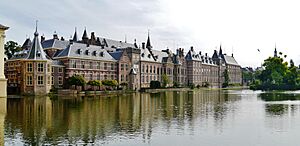
The city is becoming more student-friendly. Leiden University opened a new campus here in 2012. The Royal Conservatory of The Hague and the Royal Academy of Art are also in the city. The Hague has many government workers and diplomats. This makes the city very diverse, with many different cultures.
The Hague is the largest Dutch city on the North Sea. It has two beach resorts. Scheveningen is the main one and is very popular with tourists. It gets 10 million visitors a year. Kijkduin is the other beach resort. It is smaller and mostly visited by local people.
The former Dutch colony of the East Indies (now Indonesia) has influenced The Hague. Many streets are named after places there. There is also a large community of people with mixed Dutch-Indonesian heritage. They sometimes call The Hague "the Widow of the Indies."
The city's layout is more open than other Dutch cities. It has many parks and green areas. The Hague has a canal system around its old center. These canals are mainly used for boat tours. Many canals were drained in the past, but some have been restored.
The tallest buildings in The Hague are the Justice and Security and Interior and Kingdom Relations ministries. They are both 146 meters tall. Other tall buildings include the Hoftoren and Het Strijkijzer.
Who Lives in The Hague?
| Country/Territory | Population |
|---|---|
| 246,633 (43%) | |
| 46,346 (8.70%) | |
| 40,064 (7.52%) | |
| 31,455 (5.91%) | |
| 17,635 (3.31%) | |
| 14,094 (2.65%) | |
| 13,218 (2.48%) | |
| Other | 123,116 (26%) |
Religions in The Hague (2015) Irreligion (49.6%) Roman Catholic (14.9%) Protestant Church in the Netherlands (9.4%) Other Christian denominations (5.7%) Islam (14.7%) Hinduism (4.8%) Buddhism (0.8%) Judaism (0.2%)
As of January 1, 2021, The Hague has 549,163 residents. This makes it the third-largest city in the Netherlands. The city grew a lot between 1800 and 1960. Its population went from 40,000 to 600,000. After 1960, the population decreased for a while. But it has been growing again since then. The city expects to have over 600,000 residents by 2030.
The official term for someone from The Hague is Hagenaar. But people also informally use Hagenees for those born and raised there. These terms sometimes show a difference in social class.
Diverse Backgrounds
About 43% of The Hague's population has parents who were both born in the Netherlands. Around 15.6% have at least one parent from a Western country. And 34.4% have at least one parent from a non-Western country.
| 2020 | Numbers | % |
|---|---|---|
| Both parents born in NL | 242,441 | 44.42% |
| Western migration background | 105,315 | 19.29% |
| Non-Western migration background | 198,082 | 36.29% |
| Suriname | 45,783 | 8.39% |
| Turkey | 41,122 | 7.53% |
| Morocco | 32,355 | 5.93% |
| Indonesia | 17,187 | 3.15% |
| Netherlands Antilles and Aruba | 14,037 | 2.57% |
| Total | 545,838 | 100% |
Religion in The Hague
Just under half of the people in The Hague identify with a religious group. The most common religions are Christianity (29%) and Islam (14.1%). People with family roots in Indonesia, Turkey, Morocco, and Suriname are often more religious. Islam is very common among those with Turkish or Moroccan backgrounds. People of Surinamese heritage have many different religions, with Hinduism being the most common. Most native Dutch people who are religious are Christian.
How The Hague Makes Money
The Hague has a service-based economy. Many jobs are in government or international organizations. As of 2006, 26% of jobs in The Hague were in these areas. Major employers include various Dutch ministries.
Several large international companies have their main offices in The Hague. These include Aegon and PostNL. The city also hosts regional offices for companies like Siemens and T-Mobile. The Hague has never had much large-scale industry. However, there are many warehouses and logistical services in the Binckhorst area.
Tourism is also very important for The Hague. It is the second most popular tourist spot in the Netherlands, after Amsterdam. In 2012, 1.2 million tourists visited the city. Half of them came from other countries. Tourists spend about €2 billion a year in the local economy. About 1 in 10 residents work in the tourism sector.
Fun and Culture in The Hague
The Binnenhof is the cultural heart of The Hague. Nightlife happens around three main squares in the city center. The Plein has many outdoor cafes. The Grote Markt is also full of tables and chairs. The Buitenhof has a cinema and several bars. Next to it is De Passage, the country's first covered shopping mall. It has many expensive shops.
One of the largest music venues, Paard van Troje, is in the city center. Another popular spot is Muziekcafé de Paap. The Spuiplein is a modern square. It is home to the City Hall. It also has the new Amare theatre. This theatre hosts the Residentie Orchestra and the Nederlands Dans Theater. The Koninklijke Schouwburg theatre is also in the city center.
Scheveningen is another cultural hub. It has its own cinema and the Circustheater. In summer, the beach boulevard is full of bars and restaurants. Other attractions in Scheveningen include the miniature park Madurodam. There is also the Beelden aan Zee museum and a Sea Life Centre.
The Hague is where the Dutch monarch lives. Several royal palaces are in the city. King Willem-Alexander of the Netherlands and Queen Máxima of the Netherlands live in Huis ten Bosch. They work at the Noordeinde Palace. The Kneuterdijk Palace is now home to the Council of State of the Netherlands. The Lange Voorhout Palace houses the Escher Museum. This museum is dedicated to the artist M. C. Escher.
The Hague has many museums. The Mauritshuis is next to the Binnenhof. It shows paintings by famous Dutch artists like Johannes Vermeer and Rembrandt van Rijn. Other museums include the science museum Museon. There is also the modern art museum Kunstmuseum. The Gevangenpoort is a former prison in a 15th-century gatehouse.
The stork has been the symbol of The Hague since the 16th century. Many films and TV shows have been filmed in The Hague. Famous actors and filmmakers from the city include Paul Verhoeven.
Sports in The Hague
The city's main football club is ADO Den Haag. They play in the Eerste Divisie, the second-highest league in the Netherlands. ADO Den Haag has won the KNVB Cup twice. They also won the league twice before professional football began. Their home games are played at the 15,000-seat ADO Den Haag Stadium.
Other sports played in The Hague include rugby union and ice hockey. Darts is also popular, thanks to local champion Raymond van Barneveld. The CPC Loop Den Haag is a half-marathon race held every year.
Annual Events and Festivals
Koningsdag, or King's Day, is celebrated every year on April 27. The city fills with fairs and flea markets. People wear orange, and children sell old toys. The evening before, called King's Night, has outdoor concerts.
Every third Tuesday in September is Prinsjesdag, or Prince's Day. This is when the Dutch parliament opens. Children in The Hague have the day off school. They watch the Golden Coach carry the King to the Ridderzaal. The King reads a speech about the government's plans. Later, the Royal Family greets the public from the palace balcony.
Vlaggetjesdag (nl), or Flag Day, celebrates the arrival of the first herring of the year. Hundreds of thousands of people gather in Scheveningen. Fishing boats are decorated, and there are many activities. The first barrel of herring is auctioned for charity.
The Tong Tong Fair is the world's largest festival for Indo culture. It is one of the oldest and biggest festivals in the Netherlands. It attracts over 100,000 visitors each year. The Milan Festival is Europe's biggest Hindustani open-air event. The Hague also hosts several music festivals. These include Parkpop, a large free outdoor pop concert.
The Hague International Model United Nations is held every January. Over 4,000 students from around the world gather at the World Forum. They simulate the United Nations. Den Haag Sculptuur is an outdoor sculpture exhibition. The city also gives an award for LGBTQ+ emancipation called the John Blankenstein Award.
Getting Around The Hague
Air Travel
The Hague shares an airport with Rotterdam. You can reach it by RandstadRail Line E. However, Amsterdam Airport Schiphol is often used more by travelers. It has frequent direct trains from The Hague's main stations.
Train Travel
The Hague has two main railway stations: Hollands Spoor and Centraal Station. They are about 1.5 km apart. Centraal Station offers direct trains to most major Dutch cities. These include Amsterdam, Rotterdam, and Utrecht.
City Transport
Public transport in The Hague includes a tram network and many bus routes. These are run by HTM Personenvervoer. A tunnel was built under the city center in 2004. It has two underground tram stations.
RandstadRail connects The Hague to nearby cities. These include Zoetermeer, Rotterdam, and Leidschendam-Voorburg. It has four light rail lines and one subway line.
Roads and Motorways
Major motorways connect to The Hague. The A12 goes to Utrecht and the German border. The A4 connects the city with Amsterdam. The A13 runs to Rotterdam. There is also the A44 that connects to Leiden, Haarlem, and Amsterdam.
See also
 In Spanish: La Haya para niños
In Spanish: La Haya para niños


